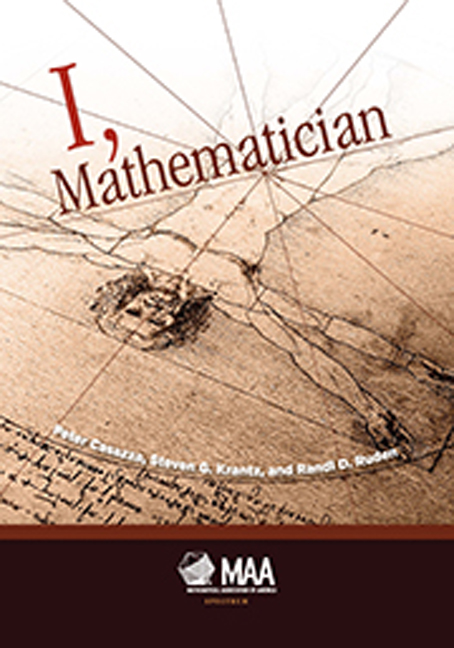Book contents
- Frontmatter
- Contents
- Preface
- Part 1 Who Are Mathematicians?
- Part II On Becoming a Mathematician
- Part III Why I Became a Mathematician
- Foreword to Why I Became a Mathematician
- 20 Why I Became a Mathematician: A Personal Account
- 21 Why I Became a Mathematician?
- 22 Why I am a Mathematician
- 23 Why I am a Mathematician
- 24 Why I am a mathematician
24 - Why I am a mathematician
from Part III - Why I Became a Mathematician
- Frontmatter
- Contents
- Preface
- Part 1 Who Are Mathematicians?
- Part II On Becoming a Mathematician
- Part III Why I Became a Mathematician
- Foreword to Why I Became a Mathematician
- 20 Why I Became a Mathematician: A Personal Account
- 21 Why I Became a Mathematician?
- 22 Why I am a Mathematician
- 23 Why I am a Mathematician
- 24 Why I am a mathematician
Summary
My earliest mathematical memory was a joyful one. The two candles on my birthday cake were a thing of beauty. As I blew out the tiny flames, I cherished that doubling of the previous year's singleton, and loved two as twice one from then on. My mother's candle geometry continued into my late teens, each display giving us a moment of shared pleasure before the pattern melted into the chocolate icing. I still associate moments of mathematical insight with the taste of fine chocolate.
When I was five, and for the next ten years, I became an explorer of the woods, a pathfinder. The woods were my haven, my creative playground. Trails and streams seemed so intimate with the land. Where did they go, where did they come from? I felt an intense longing to follow a stream wherever it led me. The stream voiced both chaos and determinism in its flow. Its mysterious source spoke of implied foundations. Unknown paths were a metaphor of life and mind, and they took me on journeys to new terrains. I was always looking for shortcuts, minimal paths to new elements. There were no words, just concepts and relationships in the woods. I learned fluid dynamics from streams, geometry from the turn of a leaf, biology from crayfish and tadpoles, and mechanics from branches blowing in the wind. Sometimes I would sit for hours in a favorite tree and think about numbers or geometrical relationships. School was a distraction from the woods.
When I was in the first grade, a group of adults came to my school to observe me. They asked me many questions. One man asked me to divide a circle into five parts. I drew a nice big beautifully symmetrical circle and made the clean divisions. Then he asked me to divide it into eleven parts. The pie slices were exactly the right size. I saw the pleasure on the faces of the adults, and enjoyed sharing the simple geometry with them.
My principal believed that accelerating bright students harmed their social development, so I was kept with my age group. To stave off boredom, I devised projects to do in all my classes. I taught myself everything; reading, arithmetic, and later, the piano. In the third grade, I learned how to take square roots, and figured out an algorithm for finding cube roots.
- Type
- Chapter
- Information
- I, Mathematician , pp. 266 - 269Publisher: Mathematical Association of AmericaPrint publication year: 2015



